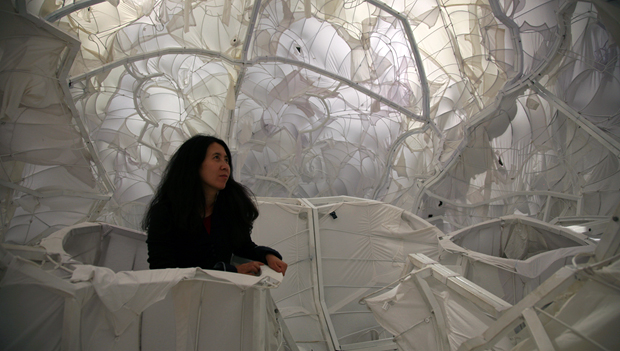
Yin Xiuzhen on China, smoking and freedom
The contemporary Chinese artist tells us about her early life, some key influences and new work
She sews sculptures from old clothing, stages environmental performances, and once covered furniture in cement dust to express her feelings towards the redevelopment of Beijing. Yin Xiuzhen is hardly the most conventional artist. Yet, as she explains in our exclusive interview, conducted over the Chinese New Year holidays, the 51-year-old Chinese artist and subject of our new monograph believes that her recurrent themes of environmentalism and globalization are universal issues, faced by all 'earth dwellers'.
Read on to understand what the Cultural Revolution meant to her, which loaf-shaped vehicle features prominently in her work, and why, breaking with tradition, she's buying, not making her daughter a new outfit this year.
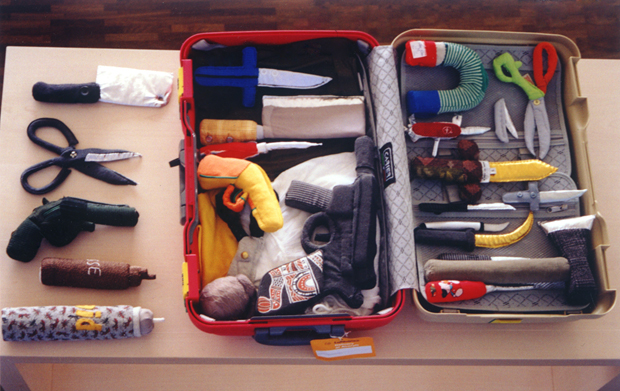
You were born before the Cultural Revolution, and before the one-child policy. How did those two events affect you and your contemporaries? "I grew up during the Cultural Revolution, and if I were to describe the state of China at the time, I would choose the word 'singular'. From clothing to food, from living conditions to transportation, everything was singular and uniform. Of course, so was the state of our thoughts! As a residue from that era nowadays whenever we see an object, or a piece of clothing, or even food from that era, all of the Chinese viewers can identify with such objects, or even feel as if they had used or came into contact with the objects personally. These objects bear the marks of that special era, and it carries our own experiences. My parents have four children, and a single child was not common for families back then. Both at school and at home the concept of 'collectivity' dominated, which fostered a strong sense of kinship and corporation during my upbringing, yet it also brought about a fierce desire for individuality. My Cultural Revolution experiences directly shaped my working method, which was to draft from one's own experiences; and they have formed my interest in the interplay between the group and the individual."
You studied oil painting at university, what sort of a painter were you? "The pedagogy at my university emphasized Social Realism, modeled after the Soviet style. My paintings bore traces of Surrealism and Expressionism, and I was interested in painting human figures."
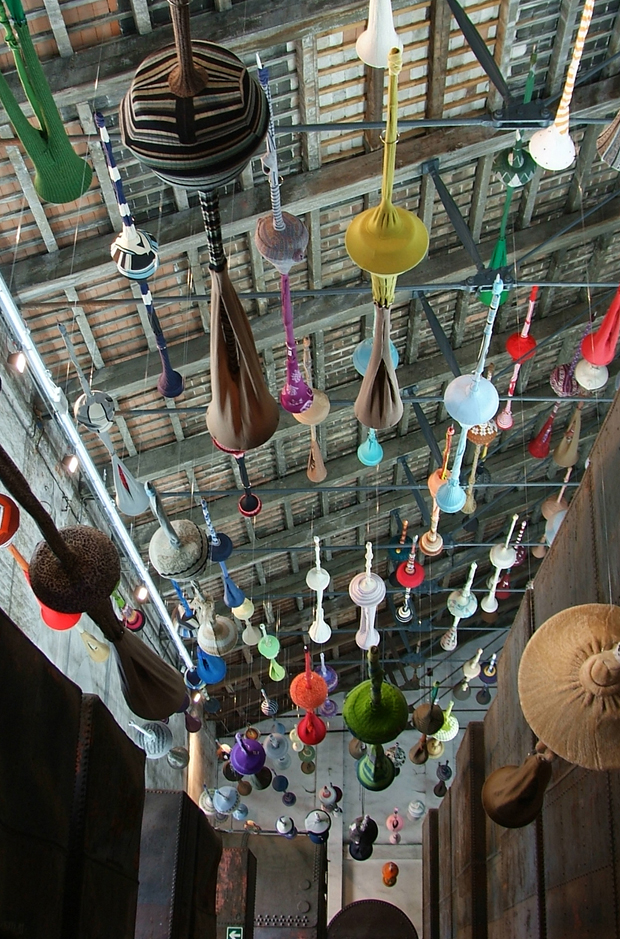
In our new book, you describe a 1995 Robert Rauschenberg exhibition as having a huge influence on you and your contemporaries. Why was it so exciting? "I recall that there were many works on view, and most of them were assembled from daily life objects and were then sprayed or painted on the surfaces. I recall specifically a sheep among the displayed works. Because I didn't own a camera at the time, there wasn't an accurate way for me to retain images or a solid memory of the show. The vibe of the exhibition along with his freedom in employing different mediums, however, really shook me to the core. I realized that the language of art should no longer be restricted to mediums and tools of painting and sculpture, which were what we had studied. Rather, it should be free and open, and should be used to express free and open messages. This exhibition ignited my desire in expressing freedom, a desire that had long been suppressed and buried."
You and your husband, the artist Song Dong, met at university. What did you have in common, practice-wise? "We share in our curiosity and adventurousness toward novelties, as well as a sense of discontent toward conservative conceptions of art. These traits gave us a common language and a shared goal."
Your mother worked as a seamstress, and taught you to sew. What was the first garment you made and the first artwork you made from cloth? "My mother made us brand new clothes every Spring Festival, and so watching her sew became an important part of my Spring Festival activities. I tried my hands on my first garment when I was in middle school, and used techniques and moves memorized from watching my mother. I sketched a short-sleeved summer shirt, with puff-sleeves and ties around its collars. I thought it was very fashionable, and used leftover clothes to make it. I later drew a self-portrait in my first self-made garment."
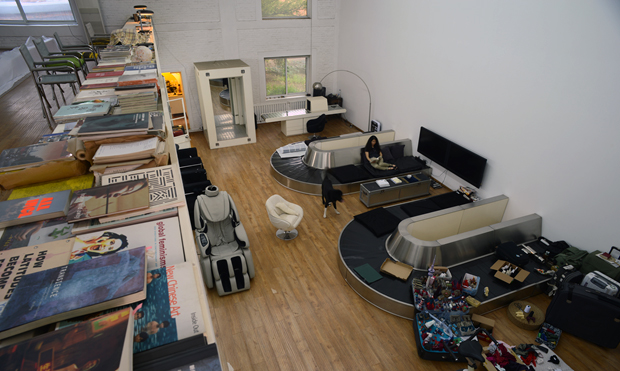
You've taken a prescient interest in both the environment and globalization. Why do you think you picked up on these two themes at such an early stage? "Art is almost inseparable from life experiences, and my living environment has been a fast-changing one. I witnessed how our sky and the environment had transformed from clear to blurry. International travels also made me realize that the world is increasingly shrinking and narrowing. Environmental issues and globalization are problems all earth dwellers face, and at the moment we have nowhere else to survive other than on this planet, so we must rethink in terms of how to coexist with this lonely planet."
Also, airports and air travel seem central to your work. Could you describe their appeal? "As air travel became universal and commonplace, distance and time differences between shrank. 'Express' transportation generated unprecedented efficiency for development and brought about huge changes and profits, but it also wiped out hard and critical thinking that a slower world would have permitted. I try to create works that solidify the fleeing into something solid and which moves slower. I hope that during such processes, I could pause, rest, and think."
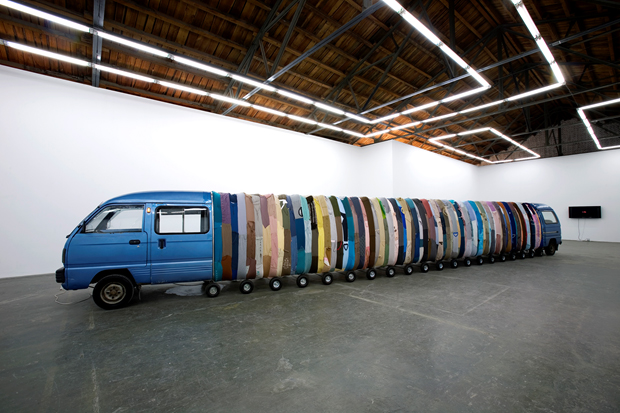
The model of minivan you adapted in Collective Subconscious was quite popular in Beijing at one point. Tell us a little about it "That model was quite popular and practical during the 90s, and it was the first car many families purchased. It could transport passengers as well as cargo, and was often used as a taxi, what we used to call 'Mian Di' ['little loaf of bread']. It was one of those taxis that the majority could have afforded, since taking an actual cab was quite a luxury back then! I took 'Mian Di' taxis a couple of times. Later on, Song Dong's sister purchased that exact model as the first car for the entire family."
Do all the cities you visit have a suitable number of landmarks to distinguish them from other cities, in order to make your soft-sculpture models, Portable City? "Yes. These cities inspired me, and some of them are looking increasingly similar, particularly cities that are recently being developed and cities in China. Among the Portable City series, the more familiar I am with one place, the fewer distinguishable landscapes I give to it, for such locality remains not in the eyes but rather in my heart. For example, I made no landmarks other than the CCTV tower in Portable City: Beijing. To me, all architecture seems rather empty, and Beijing is my home."
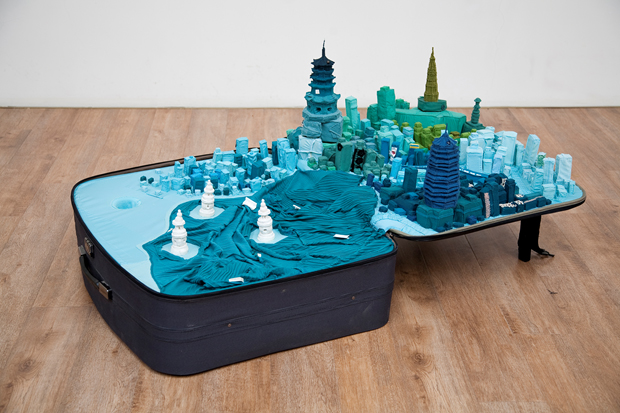
In the book you say you're returning to painting in a way. How do the new paintings differ from earlier works? "My painting these days are still concerned with current realities. Environmental degradation and globalization are still the topics of the day. My expression and language employed in installment art is migrating to painting, and the dimension of my conception and thinking are broadening. For example, the pollution smog is inescapable for us and seems surreal, yet it is precisely a cruel reality. When we look at scenes and cities under the hazy cover, under that mysterious visual experience, reality presents a killing knife and a poisonous beauty. This is what my current paintings are trying to reveal."
China has just become the world's largest economy once again. How do you feel about that? "I am thinking in terms of what we have paid for this 'largest economy', and what are we really getting from it."
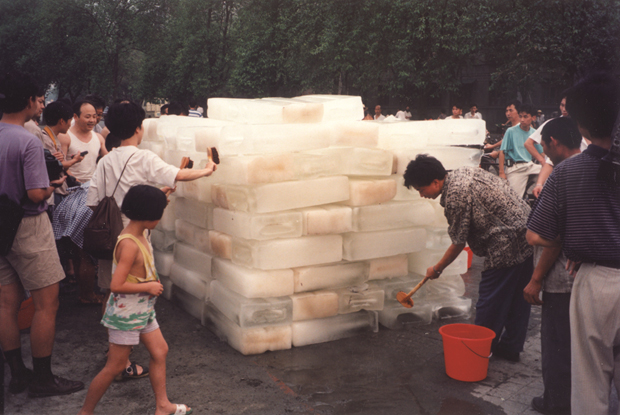
You've staged your river washing artwork in a number of different locations. Why did this particular work also suit different locations in Germany and Australia? How did the participants' reactions differ? "Environmental issues are global, so this artwork could be performed around the world. Whenever the audience participates in the collective act of river washing, they continue to think about the environment and survival, so the process of washing is also a process for thinking. Last year in Hobart, Tasmania, Australia, river washing was popular and I was impressed with the number and nature of the participants. Many parents brought along their children, and schools organized their students and came. I was grateful for this, for environmental awareness was taking root in the hearts and minds of younger children."
Your daughter has been introduced to your collaborative practice with Song Dong recently. Do you ever see yourselves working as a trio? "Perhaps, for art has become an inseparable part of my family. However, I will by no means pressure my daughter to do things that she does not want to. If she is interested in working and creating art together, we would be more than happy to have her."
What else are you working on at the moment? "I am working on the Filter Series, which is an installment of deformed and sewn body organs."
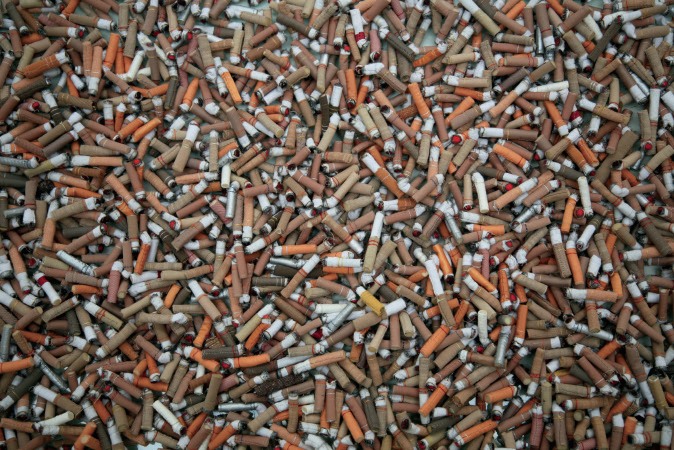
One piece that particularly intrigues us is 'Life' (2007-11), a pile of cigarette butts, sewn together from old clothing. Are they made from clothes previously worn by smokers? "The clothes were from both smokers and second-hand smokers. As long as cigarettes exist, everyone is a smoker in broad terms."
How will you celebrate the New Year? Will you be getting a new set of clothes, as you did when you were a child? "Chinese New Year is the most important festival for the Chinese people. It is the day for reunion, for fireworks that expel the old and bring out the new, for dumplings and reunion meals, for praying and wishing for good fortune to come, for visiting friends and families, and for strolling through the temple fairs and a good time with the family. This time I will be buying new clothes for my own kid!"
For more on this important artist's life and work, buy a copy of our new Yin Xiuzhen book here.